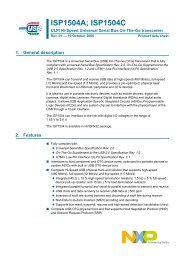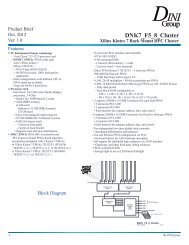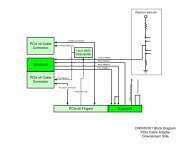User Manual
User Manual
User Manual
You also want an ePaper? Increase the reach of your titles
YUMPU automatically turns print PDFs into web optimized ePapers that Google loves.
INTRODUCTION TO VIRTEX-II PRO AAND ISE<br />
des ign hierarchy browser, and an area constraint editor. By using PACE, designers are<br />
able to observe and describe information regarding the connectivity and resource<br />
requirements of a design, resource layout of a target FPGA, and the mapping of the<br />
design onto the FPGA via location/area.<br />
This rich mixture of design entry capabilities provides the easiest to use design<br />
environment available today for your logic design.<br />
2.1.2 Synthesis<br />
Synthesis is one of the most essential steps in your design methodology. It takes your<br />
conceptual Hardware Description Language (HDL) design definition and generates the<br />
logical or physical representation for the targeted silicon device. A state of the art<br />
synthesis engine is required to produce highly optimized results with a fast compile and<br />
turnaround time. To meet this requirement, the synthesis engine needs to be tightly<br />
integrated with the physical implementation tool and have the ability to proactively<br />
meet the design timing requirements by driving the placement in the physical device. In<br />
additio n , cross probing between the physical design report and the HDL design code<br />
will further enhance the turnaround time.<br />
Xilinx ISE provides the seamless integration with the leading synthesis engines from<br />
Mentor Graphics, Synopsys, and Synplicity. You can use the synthesis engine of your<br />
choice. In addition, ISE includes Xilinx proprietary synthesis technology, XST. You<br />
have options to use multiple synthesis engines to obtain the best-optimized result of<br />
your programmable logic design.<br />
2.1.3 Implementation and Configuration<br />
Programmable logic design implementation assigns the logic created during design<br />
entry and synthesis into specific physical resources of the target device.<br />
The term “place and route” has historically been used to describe the implementation<br />
proces s for FPGA devices and “fitting” has been used for CPLDs. Implementation is<br />
fol lowed by device configuration, where a bitstream is generated from the physical<br />
place and route information and downloaded into the target programmable logic<br />
device.<br />
To ensure designers get their product to market quickly, Xilinx ISE software provides<br />
several key technologies required for design implementation:<br />
• Ultra-fast runtimes enable multiple “turns” per day<br />
• ProActive Timing Closure drives high-performance results<br />
• Timing-driven place and route combined with “push-button” ease<br />
• Incremental Design<br />
DN6000K10PCI <strong>User</strong> Guide www.dinigroup.com 32




![SODIMM Schematic [PDF]](https://img.yumpu.com/43758171/1/190x146/sodimm-schematic-pdf.jpg?quality=85)

![User's Manual [PDF - 8.3MB]](https://img.yumpu.com/36435641/1/190x245/users-manual-pdf-83mb.jpg?quality=85)







